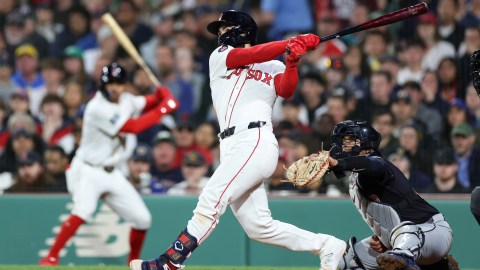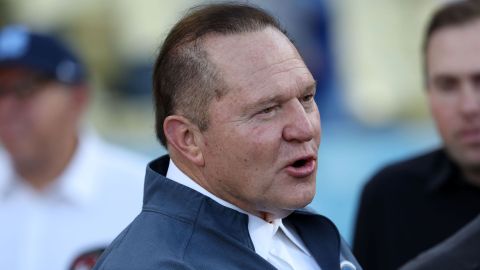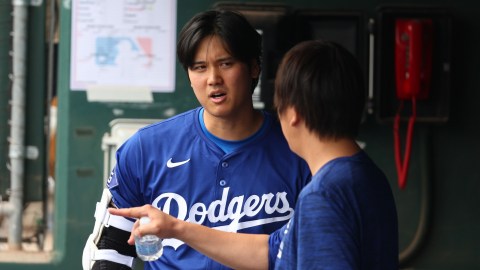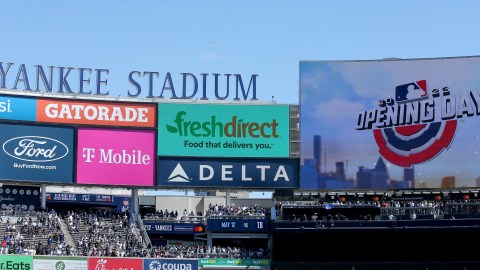 The Atlanta Braves have long sought after the Upton brothers, and this offseason they acquired both B.J. and Justin. But will Turner Field get to watch two of the most naturally gifted athletes in Major League Baseball, or two of the most enigmatic, frustrating players ever to step on the diamond?
The Atlanta Braves have long sought after the Upton brothers, and this offseason they acquired both B.J. and Justin. But will Turner Field get to watch two of the most naturally gifted athletes in Major League Baseball, or two of the most enigmatic, frustrating players ever to step on the diamond?
The truth is a little of both. While Atlanta gave up a fair amount in terms of prospects — not to mention Martin Prado, the guy they projected to take over at third base for Chipper Jones — right now it gives them perhaps the second-best outfield in baseball, behind the Angels and whoever they team up with Josh Hamilton and Mike Trout. Combining the Upton brothers with Jason Heyward gives Atlanta one of the most athletic, flatly talented outfields ever.
But it still won’t make them an N.L. East champion in 2013.
The problem is, as talented as we know the Uptons are, a large part of the infatuation with them is based on what evaluators think they’re capable of, not how they’ve actually produced in the past. B.J. in particular, is a player who has almost undoubtedly hit his ceiling, and that ceiling has turned out to be a player who’s fallen far short of expectations and talent.
That being said, the players that the Braves are getting, while underachievers, aren’t anything to scoff at, either. Though B.J. has one season under his belt — all the way back in 2007 — with an OPS above .800, he’s also developed into one of the best center fielders in baseball. Moreover, when he’s hot, B.J. is absolutely capable of carrying a team for short stretches, such as when he put the Rays on his back toward an ill-fated playoff drive last September and October, in which he hit 12 home runs in 30 games and slugged .605.
However, anyone looking at the numbers understands that that kind of production from the elder Upton isn’t sustainable, even for a 28-year-old in the prime of his career. During that late-season push, despite the impressive power display, Upton’s value was limited by a sub-.300 on-base percentage.
Justin, meanwhile, has undoubtedly the higher ceiling of the two, but likewise suffers from a great disparity between perception and reality. Justin has already gained a reputation in his short career as an every-other-year kind of hitter, with slugging percentages of .532 and .529 in 2009 and 2011, respectively, tempered by .442 and .430 marks in 2010 and 2012. In short, Justin is an offensive asset, but he’s not the star that the crop of talent the Braves gave up to acquire him would indicate.
So, for all the talent the Braves’ outfield possesses, it’s also comprised of three players — Heyward included — who have yet to produce in line with their name recognition and perceived talent. Of course, Justin Upton and Heyward in particular, at ages 25 and 23, respectively, could yet break out. However, the incredibly high strikeout totals both have generated indicate players with inherent flaws in their offensive attack who might have a difficult time improving their overall production without improving their peripherals.
And, more to the point, as great as the Braves’ outfield is, it doesn’t make them a better team than the Washington Nationals heading into 2013. It doesn’t even make them a better team than the Cincinnati Reds, if we’re looking beyond the A.L. East.
While the Braves are hoping that their outfield anchors the offense and are essentially praying Brian McCann returns to health and Dan Uggla doesn’t hurt them as much as he did in 2012, the Nationals have every reason to believe they could be even better next season than they were last year.
While Adam LaRoche will undoubtedly come down to Earth a little bit, the Washington’s biggest offseason loss was left-handed reliever Sean Burnett. Meanwhile, if Jayson Werth can remain healthy, his plate discipline means he will always help the team, and Bryce Harper looks poised to become an offensive force at age 20 after last season’s monster September and October. Given that it’s often overlooked that Harper, for all his rookie struggles, had an .817 OPS last season, the Nationals could essentially be adding a middle-of-the-order bat to their lineup while giving up nothing.
The Braves, meanwhile, are also trying to replace the lost production of Jones and Prado, who combined for an OPS of at least .800 (or very, very close to it) in four of the last five seasons. So while Atlanta did bring in some talent, they also have to account for the production they’re losing from their lineup.
The Nationals, meanwhile, remain intact.
So, once again, for all the talent that the Braves have piped into their outfield, keep in mind not only that it’s a threesome of players with inherent flaws, but that they’re replacing players in the Atlanta lineup that have long been pluses in the offensive column. The Braves’ outfield may be one of the most fun-to-watch unit’s baseball’s ever seen, but the Nationals are a much stronger team top to bottom, and ought to capture the A.L. East again in 2013.



